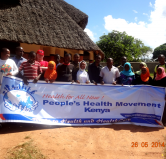
Region: Africa
Language: English
Year: 2016
Source: Contribution for manual
Author(s): A sub-group of PHM Kenya drafted this contribution (Ravi Ram, Erick Otieno, Dan Owalla, Bernadette Muyomi, Kamlas Oodhus). The draft was shared with the PHM Kenya email list, and all suggestions from members have been incorporated.
Summary: History of the PHM Kenya circle, established by several health rights groups, with a base in Nairobi and active outreach with partners and activities in various parts of the country. Membership expanded greatly with an IPHU held in western Kenya. PHM Kenya has been through periods of active collaboration, internal disagreements, routine meetings and also times when members work for health for all independently of the movement. Additionally, PHM Kenya along with PHM Uganda and others in the region have at times supported regional health rights through an informal grouping called PHM East Africa. The regional engagement has been useful, and helps to generate a wider solidarity around health rights even though it is not always active. Lessons to share: 1) Do not focus too much on internal matters. The most important things are to have a core group of committed members and to encourage diversity in the background of members, which brings different skills, perspectives and resources. 2) Start first by building a country movement through collaboration and solidarity, by linking with the existing work of members. 3) Obtaining funds and assets can be both a benefit and a source of problems. Managing and sharing internal assets among different groups can provoke conflict and undermine solidarity of the movement. Consider carefully about collaborating with separate funding managed by members themselves, versus creating a joint programme with shared assets. 4) Plan on how to handle conflicts among members before they happen, and be sure that all value solidarity so that the movement does not suffer. 5) Sometimes the movement appears to go quiet, but in reality there is a lot happening by members themselves. 6) Use as much communication as possible.
For more information on this experience, please write to Ravi Ram at [email protected].
Key practices: relationships; decision-making, structure and organisation; communication; networking
Read the full report here

